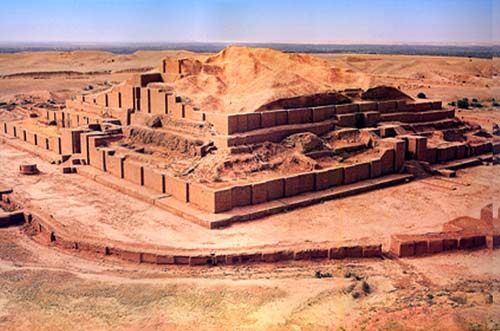|
Other Archaeological Sites / The Neolithic of the Levant (500 Page Book Online) Ancient Chogha Zanbil
Location: About 125 miles north of the northern tip of the Persian Gulf, 25 miles southeast of Susa and 90 miles north of Ahvaz in ancient Elam, now the southwestern Iranian province of Khuzestan. Description: Ruins of the Elamite city of Dur-Untash including the largest known ziggurat. Built around 1250 B.C. by King Untash-Gal and destroyed in 640 BC by the Assyrian king Ashurbanipal. Surrounded by ruins of fortification walls, three palaces and other temples. Chogha Zanbil is the modern name for Dur-Untash, an Elamite city founded in approximately 1250 B.C. Dur-Untash was the capital city of King Untash-Gal. The ziggurat is both the largest in the world and the best surviving example of Elamite architecture. Although Untash-Gal's successors preferred Susa as their capital city, Dur-Untash remained a royal city for about seventeen hundred years. Rediscovered in 1935, it has been extensively excavated (1). The Kingdom of Elam was a large state on the western flanks of the Zagros Mountains. Its chief city Susa was founded in the late fifth millenium B.C. Untash-Gal, a thirteenth-century B.C. Elamite monarch who ruled for over twenty years, was an ambitious builder and his name is associated with extensive restoration and new construction of religious buildings at Susa. However in the mid-thirteenth century he left Susa in order to found his new capital city and religious center about twenty-five miles to the southeast. Dur-Untash was a very large city covering over one hundred hectares. Dur-Untash itself first developed as a pilgrimage town intended to accommodate large numbers of people. The center of the ancient city is the ziggurat which is surrounded by the ruins of smaller temples, fortification walls, a palace and a funeral palace. The ziggurat, whose immense ruins are still three stories tall, is situated on a square base elevated above the plain and enclosed by a protective wall three yards thick. Both platform and wall were protection against flooding. The surviving three-stories of the ziggurat are approximately eighty feet high although its original height is estimated at over one hundred and sixty feet. The entrance to the first story is small, indicating that only a very limited number of people could enter as officiants or visitors of distinction. In fact the ziggurat, a temple built on a stepped pyramid, is a kind of artificially elevated site for religious worship. Both pyramids and ziggurats have been described as artificial mountains and may have been intended to visibly demonstrate the social or spiritual superiority of the elite or priestly class who had sole access to the uppermost temples. Interestingly the construction of the first story of the ziggurat at Dur-Untash suggests that the temple was turned into a ziggurat only as an afterthought; which would help to explain why there is only one stairway leading to the top. The first story originally consisted of a double row of rooms built around an inner courtyard. The rooms on the southeast side were temples to the god In-Shushinak. When the courtyard was filled in and the other stories of the ziggurat added on top, the lower levels remained dedicated to In-Shushinak alone but the uppermost temple was dedicated to both In-Shushinak and another god, Napirisha. Abandoned for well over a thousand years, Dur-Untash was rediscovered by accident during an aerial survey carried out for a petroleum company in 1935. It was given its modern name of Chogha Zanbil, or “basket mound", because the ziggurat looked like an upside-down basket before its excavation. The site was not systematically excavated until 1951. The royal residence was recovered in 1958. Under the palace is a vaulted tomb chamber as well as the ruins of a complex water and sewage system. Under the west wall five carefully sealed and concealed crypts contained an intact human skeleton as well as the cremated remains of two more bodies and piles of weapons, ornaments and clothing. In another crypt incinerated human remains had been placed on the floor in groups. This evidence of the burning of human remains is unique in Elam and probably has a connection with the cult of Nusku. It is clear that the civilization of Dur-Untash was technologically advanced. Items found at the site include ivories, a carved stone stele and an enormous bronze statue. The statue, a now-headless image of Napirasu, the wife of Untash-Gal, weighs over 1750 kilograms and it has not yet been determined how the workers created such a huge bronze statue using contemporary metal-working techniques.
(1) International Dictionary of Historic Places: Middle East and Africa Volume 4 (1994)
|

